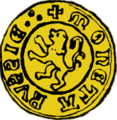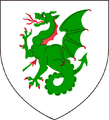Halych-Volyn Principality
Roman the Great united the principalities of Galicia and Volhynia at the turn of the 13th century. Following the destruction wreaked by the Mongol invasion of Kievan Rus' (1239–1241), Prince Daniel of Galicia and the other princes of Rus' pledged allegiance to Batu Khan of the Golden Horde in 1246. The Polish conquest of the kingdom in 1349 led to it being fully absorbed by Catholic Poland. Upon annexing it in 1349, Polish king Casimir III the Great adopted the title of King of Poland and Ruthenia, and the territory was transformed into the Ruthenian Voivodeship (Latin: Palatinatus Russiae) in 1434.
History
Origins
The Principality of Volhynia may have emerged as early as the late 10th century, with Vsevolod, a son of Vladimir I of Kiev, mentioned as a prince of the city of Volodymyr. Igor Yaroslavich reportedly briefly reigned as the prince of Volodymyr in the 1050s. Iaroslav Sviatopolkovich (r. 1100–1118) was the only prince in Kievan Rus' to oppose Vladimir II Monomakh's reign on the grounds of agnatic seniority, but after Vladimir ousted him in 1118, his Monomakhovichi descendants established a local dynastic branch. Roman Mstislavich, the great-great-grandson of Monomakh, inherited the throne of Volhynia in 1170.
The Principality of Galicia was formed in the years 1124–1144 by Vladimirko Volodarovich's unification of the principalities of Zvenyhorod, Peremyshl, and Terebovlia. Since the 1080s or 1090s, all three had been ruled by sons of prince Rostislav of Tmutarakan, who may or may not also have been a prince in Volhynia and Galicia c. 1054/1060 to 1067.
Both Volhynia and Galicia had experienced a remarkable economic development in the 12th century due to their commercial advantages. In part, this was because land trade routes in Asia Minor were severely disrupted due to the Byzantine–Seljuk wars (1046–1243), diverting numerous merchants coming from the east heading for Constantinople via Alexandria in Egypt, while others circumvented Anatolia via the port of Sudak (Sougdaia) in Crimea. The flourishing of the latter commercial hub soon attracted Kievan Rus' traders, who rerouted some of the would-be Byzantine goods (occasionally through itinerant Jewish merchants) to Poland, Hungary, Bohemia and Germany, via the towns of Volhynia and Galicia.
Their new status as transit hubs for commerce between the northern Black Sea ports and central Europe brought Galicia and Volodimer-in-Volhynia tremendous wealth and increasing political power in the late 12th century. Trade and salt mining in particular empowered the boyar class of Galicia, who were able to challenge and undermine the authority of the Rostislavichi princes. Galicia and Volhynia merged around 1198 or 1199 into the principality of Galicia–Volhynia. This happened when the local Galician branch of the Rostislavichi clan died out, and Roman Mstislavich of Volhynia also took possession of Galicia, establishing a dynastic union.
Reign of Roman the Great (1199–1205)
Galicia–Volhynia was created following the death in 1198 or 1199 (and without a recognized heir in the paternal line) of the last Prince of Galicia, Vladimir II Yaroslavich. Roman acquired the Principality of Galicia and united his lands into one state. He did so upon the invitation of the boyars of Galician boyars, who expected that Roman would be an "absentee" Volhynian prince ruling from afar so that they could increase their own power. On the contrary, Roman curbed their power, expelled any boyar who opposed him, and increased the influence of the urban and rural populace.
In Roman's time Galicia–Volhynia's principal cities were Halych and Volodymyr. Roman was allied with Poland, signed a peace treaty with Hungary and developed diplomatic relations with the Byzantine Empire. The grand prince of Kiev, Rurik Rostislavich (Rurik II), forged a coalition of Rus' princes and attacked Galicia-Volhynia, but Roman defeated them and captured Kiev in 1200. However, because the old capital of Kievan Rus' was no longer a strong power centre by that time, Roman kept the prosperous Halych as his capital and appointed subordinates to administer Kiev in his name. He then mounted two successful campaigns against the Cumans, in 1201–2 and 1203–4. In 1203 Roman also extended his rule to the Principality of Pereyaslavl. During his absence, Rurik II retook and heavily sacked Kiev in 1203 with the help of Polovtsians and Chernihivians. In 1204 Roman recaptured Kiev once more, marking the height of his reign: he briefly became the most powerful of the Rus' princes. He married the niece of the Byzantine emperor Alexios III, for whom Galicia was the main military ally against the Cumans. The relation with Byzantium helped to stabilize Galicia's relations with the Rus' population of the Lower Dniester and the Lower Danube.
War of succession (1205–1245)
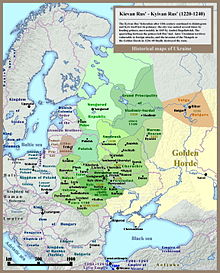
In 1205, Roman's alliance with the Poles broke down, leading to a conflict with Leszek the White and Konrad of Masovia. Roman was subsequently killed by Polish forces in the Battle of Zawichost (1205), triggering a war of succession, while his dominion entered a period of rebellion and chaos that lasted almost 40 years. In this time, the Galician boyars made efforts to prevent the establishment of a hereditary princely dynasty, especially by Roman's son Daniel, and instead put all sorts of puppets on the throne which they could easily control. Thus weakened by war between Galician boyars and some appanage princes, Galicia–Volhynia also became an arena of rivalry between Poland and Hungary, which intervened in the region several times. Roman's successors would mostly use Halych (Galicia) as the designation of their combined kingdom. King Andrew II of Hungary styled himself rex Galiciæ et Lodomeriæ, Latin for "king of Galicia and Vladimir [in-Volhynia]", a title that was later adopted by the House of Habsburg.
After Roman's death, the Galician boyars first drove Roman's widow Anna-Euphrosyne and two sons Daniel and Vasylko from the region. From 1206 to 1212, the Principality of Galicia was controlled by the three sons of the Novgorod-Seversk prince Igor Svyatoslavich: Vladimir III Igorevich, Svyatoslav III Igorevich, and Roman II Igorevich. They were defeated by Galician boyars, and the boyar Volodyslav Kormylchych assumed the throne of Galicia in 1213 or 1214, the only non-Rurikid ever to rule any of the Rus' principalities. After he was removed, a compromise agreement was concluded in 1214 between Hungary and Poland, who partitioned the Galician lands. The throne of Galicia–Volhynia was given to Andrew's son, Coloman of Lodomeria, who had married Leszek the White's daughter, Salomea.
In 1221, Mstislav Mstislavich, son of Mstislav Rostislavich (descendant of the princes of Novgorod), liberated Galicia–Volhynia from the Hungarians and Poles. During Mstislav's 1221–1228 reign, the Galician and Volhynian armies participated in the Battle of the Kalka River (1223) against the Mongols, but in 1228 the boyars expelled him and transferred the Principality of Galicia to the king of Hungary. It was Daniel of Galicia, son of Roman, who formed a real union of Volhynia and Galicia. Daniel first established himself in Volhynia. After failing to retake his father's other throne in 1230–1232 and 1233–1235, Daniel succeeded upon his third attempt and conquered Galicia in 1238, reunited Galician and Volhynia, and ruled for a quarter century. In March 1238, he defeated the Teutonic Knights of the Order of Dobrzyń in the Battle of Dorohychyn. Daniel captured Kiev in 1239, just before the Mongols besieged, conquered and sacked the city in late 1240. On 17 August 1245, Daniel and his brother Vasylko defeated the Polish and Hungarian forces (weakened by the first Mongol invasion of Poland and the first Mongol invasion of Hungary in early 1241) in the Battle of Yaroslav (Jarosław), taking full control of Galicia–Volhynia. The brothers also crushed their ally Rostislav Mikhailovich, son of the prince of Chernigov.
Reign of Daniel (1245–1264)
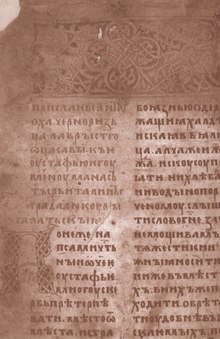
Daniel strengthened his relations with Batu Khan by traveling to his capital Sarai and acknowledging, at least nominally, the supremacy of the Mongol Golden Horde. After meeting with Batu Khan in 1246, Daniel reorganized his army along Mongol lines and equipped it with Mongolian weapons, although Daniel himself maintained the traditional attire of a Rus' prince. According to Vernadsky (1970), Daniel's alliance with the Mongols was merely tactical; he pursued a long-term strategy of resistance to the Mongols. On the other hand, Magocsi (2010) argued that Daniel submitted to the Mongols, citing the Galician–Volhynian Chronicle, which decried Daniel 'is now on his knees and is called a slave' and called this event 'the greatest disgrace'. Magocsi stated that, 'although he never acknowledged it', Daniel was a Mongol vassal, who collected the Mongol tribute, and generally helped 'establishing Mongol administrative control over eastern Europe in cooperation with those Rus' princes who could be made to see the advantages of the new Pax Mongolica.' According to Magocsi, Daniel's submission to the Mongols ensured the strength and prosperity of Galicia–Volhynia. He did renew his alliances with Hungary, Poland and Lithuania, making plans to forge an anti-Mongol coalition with them to wage a crusade against the Khan; although these were never carried out, it would eventually lead to Daniel's royal coronation by papal legate in 1253. This brought Galicia–Volhynia into the orbit of the western European feudal order, and the Roman Catholic Church.
In 1245, Pope Innocent IV allowed Daniel to be crowned king. Daniel wanted more than recognition, commenting bitterly that he expected an army when he received the crown. Although Daniel promised to promote recognition of the Pope to his people, his realm continued to be ecclesiastically independent from Rome. Thus, Daniel was the only member of the Rurik dynasty to have been crowned king. Daniel was crowned by the papal legate Opizo de Mezzano in Dorohochyn 1253 as the first King of Ruthenia (Rex Russiae; 1253–1264). In 1256, Daniel succeeded in driving the Mongols out of Volhynia, and a year later he defeated their attempts to capture the cities of Lutsk and Volodymyr. Upon the approach of a large army under the Mongolian general Boroldai in 1260; however, Daniel was forced to accept their authority and to raze the fortifications he had built against them.
Under Daniel's reign, the Kingdom of Galicia–Volhynia was one of the most powerful states in east central Europe, and it has been described as a 'golden age' for Galicia–Volhynia. Literature flourished, producing the Galician–Volhynian Chronicle. Demographic growth was enhanced by immigration from the west and the south, including Germans and Armenians. Commerce developed due to trade routes linking the Black Sea with Poland, Germany, and the Baltic basin. Major cities, which served as important economic and cultural centers, included Lviv (where the royal seat would later be moved by Daniel's son), Volodymyr, Halych, Kholm (Daniel's capital), Peremyshl, Dorohychyn, and Terebovlya. Galicia–Volhynia was important enough that in 1252, Daniel was able to marry his son Roman to Gertrude of Babenberg, heiress of the Duchy of Austria, in the vain hope of securing the latter for his family. Another son, Shvarn, married a daughter of Mindaugas, Lithuania's first king, and briefly ruled that land from 1267 to 1269. At the peak of its expansion, the Galician–Volhynian state contained not only south-western Rus lands, including Red Ruthenia and Black Ruthenia, but also briefly controlled the Brodnici on the Black Sea.
Reign of Leo I (1264–1301)
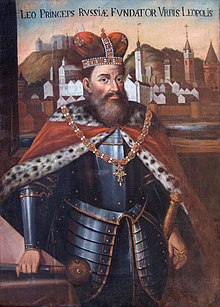
After Daniel's death in 1264, he was succeeded by his son Leo, who moved the capital from Chełm to Lviv in 1272 and for a time maintained the strength of the Kingdom of Galicia–Volhynia. Unlike his father, who pursued a Western political course, Leo worked closely with the Mongols, in particular cultivating a close alliance with the Tatar Khan Nogai. Together with his Mongol allies, he invaded Poland. However, although his troops plundered territory as far west as Racibórz, sending many captives and much booty back to Galicia, Leo did not ultimately gain much territory from Poland. Leo also attempted, unsuccessfully, to establish his family's rule over Lithuania. Soon after his brother Shvarn ascended to the Lithuanian throne in 1267, he had the former Lithuanian ruler Vaišvilkas killed. Following Shvarn's loss of the throne in 1269, Leo entered into conflict with Lithuania. From 1274 to 1276 he fought a war with the new Lithuanian ruler Traidenis but was defeated, and Lithuania annexed the territory of Black Ruthenia with its city Navahrudak. In 1279, Leo allied himself with king Wenceslaus II of Bohemia and invaded Poland, although his attempt to capture Kraków in 1280 ended in failure. That same year, Leo defeated Hungary and annexed part of Transcarpathia, including the city of Mukachevo. In 1292, he defeated fragmented Poland and added Lublin with surrounding areas to the territory of his kingdom.
Decline (1301–1340)

After Leo's death in 1301, a period of decline ensued. Leo was succeeded by his son Yuri I, who ruled for only seven years. Although his reign was largely peaceful and the Galicia–Volhynia flourished economically, Yuri I lost Lublin to the Poles in 1302. From 1308 to 1323, Galicia–Volhynia was jointly ruled by Yuri I's sons Andrew and Leo II, who proclaimed themselves to be the kings of Galicia–Volhynia. The brothers forged alliances with King Władysław I of Poland and the Teutonic Order against the Lithuanians and the Mongols, but the Kingdom was still tributary to the Mongols and joined the Mongol military expeditions of Uzbeg Khan and his successor, Janibeg Khan. The brothers died together in 1323, in battle, fighting against the Mongols, and left no heirs.
After the extinction of the Rurikid dynasty in Galicia–Volhynia in 1323, Volhynia passed into the control of the Lithuanian prince Liubartas, while the boyars took control over Galicia. They invited the Polish prince Yuri II Boleslav, a grandson of Yuri I, to assume the Galician throne. Boleslaw converted to Orthodoxy and assumed the name Yuri II. His encouragement of foreign colonization led to conflicts with the boyars, who then poisoned him in 1340 and offered the throne to Liubartas, within the same year Casimir III of Poland attacked Lviv.
Final years and aftermath (1341–1392)

In winter 1341 Tatars, Ruthenians led by Detko, and Lithuanians led by Liubartas were able to defeat the Poles, although they were not so successful in summer 1341. Finally, Detko was forced to accept Polish overlordship, as a starost of Galicia. After Detko's death, Casimir III mounted a successful invasion, capturing and annexing Galicia in 1349.

The Romanovichi (branch of the Rurikid) dynasty of Daniel of Galicia attempted to gain support from Pope Benedict XII and broader European powers for an alliance against the Mongols, but ultimately proved unable to compete with the rising powers of the centralised Grand Duchy of Lithuania and the Kingdom of Poland. Only in 1349, after the occupation of Galicia–Volhynia by an allied Polish-Hungarian force, was Galicia–Volhynia finally conquered and incorporated into Poland. This ended the vassalage of Galicia–Volhynia to the Golden Horde.

From 1340 to 1392, the civil war in the region transitioned into a power struggle between Lithuania, Poland, and Hungary. The first stage of conflict led to the signing of a treaty in 1344 that secured the Principality of Peremyshl for the Crown of Poland, while the rest of the territory belonged to a member of the Gediminid dynasty of Liubartas. Eventually by the mid-14th century, the Kingdom of Poland and the Grand Duchy of Lithuania divided up the region between them: King Casimir III took Galicia and Western Volhynia, while the sister state of Eastern Volhynia together with Kiev came under Lithuanian control, 1352–66.
Following the death of Casimir the Great in 1370, Galicia–Volhynia was ruled by Vladislaus II of Opole in 1372–1379 and 1385–1387, as Lord of Ruthenia (Terre Russie Domin), being a descendant of princes of Belz and a subject of King Louis I of Hungary. Vladislaus strongly contributed to the establishment of Roman Catholic Archdiocese of Lviv as part of Polish Catholicisation.
Geography
Geographically, western Galicia–Volhynia extended between the rivers San and Wieprz in what is now south-eastern Poland, while its eastern territories covered the Pripet Marshes (now in Belarus) and the upper reaches of the Southern Bug river in modern-day Ukraine. During its history, Galicia-Volhynia was bordered by the Grand Duchy of Lithuania, the Principality of Turov-Pinsk, the Principality of Kiev, the Golden Horde, the Kingdom of Hungary, the Kingdom of Poland, Moldavia and the Monastic State of the Teutonic Knights.









